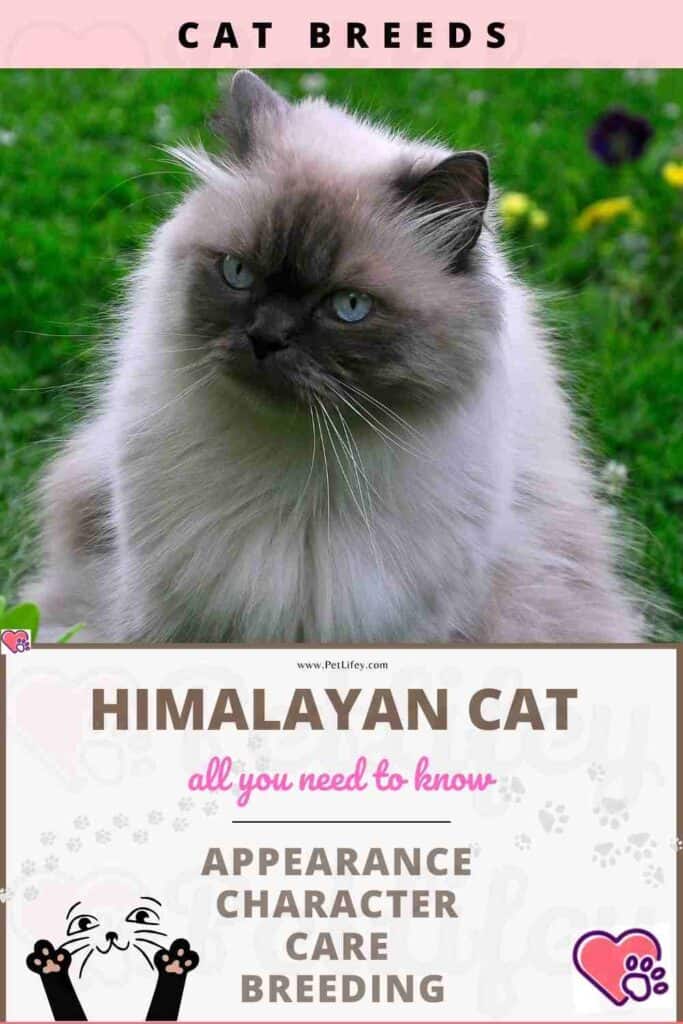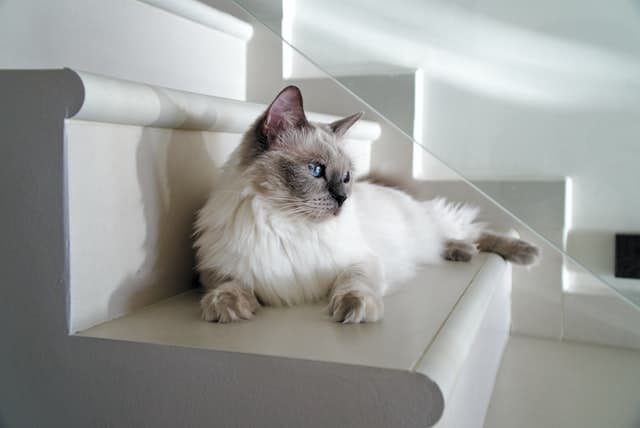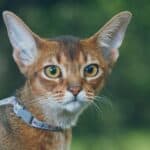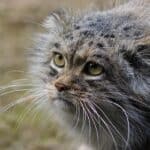
The Himalayan or Persian color point, comes from the Persian and the Siamese for color and type. It is a perfect companion, as beautiful to look at as it is to live!
His Siamese origins give him a more assertive sense for play and playfulness, while his Persian origins make them a calm cat, very affectionate and attached to humans, often in demand of attention.
The origins of the Himalayan Cat

The Himalayan, also called Persian colourpoint, is a breed of cat that originated in the United States. This name is given to them in reference to a breed of domestic rabbit from the Himalayas that bears these same colors.
The Himalayan as we know it today is the result of a research program launched in Great Britain and the United States in 1947. It is a cross between a Siamese cat with medium hair. and blue and black Persians. The breed was recognized in England in 1955 and in the United States in 1957.
Although the Himalayan is considered a special division of the Persian breed, it is considered a breed in its own right by TICA, WCF, and ACFA.
Appearance of the Himalayan Cat
The Himalayan, Persian colorpoint, has an identical standard to the Persian. A massive body, but round, on legs rather short but strong and robust. Its feet are round, large, with close together toes and covered with long tufts of hair.
Its face is round, with a broad skull, well highlighted by an imposing ruff. Its nose is wide and turned up with a marked stop. In profile, the forehead, nose and chin should line up on the same vertical line. Its ears are small, with rounded ends and well spaced apart. Her big round eyes are always an intense blue.
Its coat is long and shiny with a thick undercoat. The dress is always colourpoint, with an identical distribution of dark markings on the face, ears, feet and tail. All colors are accepted, as well as tabby and tortie point markings.
Coat color of the Himalayan Cat
Its color is very white, very light, when it is small, and darkens a little when it ages. So you have to wait until the Himalayan cat is between 1 and 3 years old to see its final color.
The most famous colors are seal point, blue point and red point. There are, however, chocolate point, lilac point, crème point, tortie point, and there are also smoke points and shaded points.
The character of the Himalayan Cat
The Himalayan is a playful, playful, curious cat, while being very affectionate, poised and gentle! It adapts very well to apartment living. Very sociable, it likes the presence of people and likes to be taken care of. In this it is also a very easy cat to handle.
Hug:
The Malaysian Persian will stay for hours on his human’s lap, purring with pleasure under the scratches and caresses.
Player:
The Himalayan is more playful than the Persian because it inherited the genes of the Siamese. It can be very malicious.
Calm:
Softness and calm are among its main qualities.
Intelligent:
Sometimes qualified as mischievous and mischievous, it is a fairly intelligent cat who will surprise you from time to time!
Fearful / suspicious of strangers:
Sociable, this cat is not necessarily fearful of strangers, even if it takes a little time to adapt.
Independent:
The Himalayan enjoys being the centre of attention and is close to his humans. It needs attention and does not cope with loneliness.
Behavior of the Himalayan Cat
Talkative:
The Malaysian Persian is a cat who meows little but can make themselves understood with a glance.
Gourmand / glutton:
This peaceful gourmand will tend to binge. Using interactive bowls can limit food intake but also stimulate it physically and intellectually.
Need for exercise:
Daily play sessions should be limited and of low intensity due to its morphology. But that doesn’t mean there shouldn’t be.
Runaway:
The Himalayan prefers, by far, the comfort of its home to outdoor escapades.
Compatibility of the Himalayan Cat with other animals
The Himalayan and the Dogs:
Rather calm, it will get along with dogs who will share this character trait with them.
The Himalayan and Other Cats:
Life in a feline community may suit them provided the environment is suitable and the introduction has been properly made.
The Himalayan and the Children:
Playful, the Persian from Malaysia will appreciate the company of children who will be gentle and respectful with him. But beware of unruly children who will not mix well with this feline!
The Himalayan and the Elderly:
It is undoubtedly one of the most suitable cat breeds to keep a calm person company as long as they can get down to grooming on a daily basis.
Price of the Himalayan Cat
On average, the purchase price of a Himalayan kitten in breeding is between 950 USD and 3000 USD , the price often varying according to the line, the breeding, the age or even the sex. For the monthly budget, it will take an average of 50 USD / month to meet his needs, by offering him a quality diet and making sure to maintain him in good health.
Maintenance of the Himalayan Cat
Grooming:
Grooming the Himalayan is particularly demanding: brushing should be daily to avoid knots and remove dead hair. This can be more easily removed with a bath, followed by good drying. The long hairs on the hindquarters can sometimes be soiled by the stool, and should therefore be checked regularly. Cutting and mowing will sometimes be necessary to facilitate maintenance.
Cleaning the eyes and wings of the nose must also be daily due to its flat face. Indeed, the secretions can color his very light hair but also cause infections. Remember to check the cleanliness of the ears frequently.
Hair loss:
Like all Persians, the Himalayan loses a lot of hair.
Diet:
The choice of diet will be greatly influenced by the physical and morphological characteristics of the breed. To guarantee the shine of the coat and the good health of this breed, the food chosen must be of very good quality.
Caring for the Himalayan Cat
The Himalayan, like the Persian, requires special attention. Its fur requires regular brushing, because otherwise the hair tends to felt and get tangled.
Due to its morphology, the Persian colorpoint also encounters some weaknesses on the side of the nose and eyes; also it is necessary to clean them regularly.
Health of the Himalayan Cat
Life
expectancy : The life expectancy of the Himalayan is quite large since it depends on the individual but above all on the genetic characteristics of the animal. It can therefore live up to 10 or 15 years.
Resistant / robust:
Apartment cat par excellence, extreme temperatures are not for them.
Tendency to gain weight:
Its home-like and greedy side is likely to lead to overweight. The quality and quantity of food to be offered must therefore be monitored. The interactive bowls could be a good solution to feed them since the cat would be stimulated both physically and intellectually.
Common diseases:
Like many feline breeds, Persians in general, and therefore Himalayans, are predisposed to develop certain hereditary diseases:
Nephrology-urology:
- Polycystic kidney disease: cysts gradually and slowly appear on the kidneys, hindering their proper functioning. There is a screening test for this disease
- Idiopathic cystitis: This inflammation of the bladder is often seen in castrated males. There are many causes but often unidentified
- Urolithiasis (or urinary stones): they usually appear after the age of 7, mostly in sterilized animals and males
Cancerology:
- Basal cell tumor: mostly benign, these skin tumors are often located in the head and neck
- Tumor of the sebaceous glands: these benign skin tumors can be single or multiple
Cardiology:
- Hypertrophic heart disease: heart disease characterized by thickening of the myocardium
- Pericardo-diaphragmatic hernia: an abnormality in the development of the diaphragm leading to the passage of the abdominal organs into the pericardial cavity
Ophthalmology:
- The progressive retinal atrophy which causes loss of vision almost from birth
- Corneal sequestration (or corneal necrosis)
- Coloboma of the eyelids: malformation of the outer part of the upper eyelids
- Entropion: malformation causing the edge of the eyelid to roll inwards
- Idiopathic epiphora: tear secretion abnormality linked to the shape of the cat’s head
Dermatology:
- Ringworm : a yeast infection most often developing on the back or at the base of the tail, causing ulcerated nodules
Cryptorchidism, testicular monorchidism: absence of descent of the testes or of a single
It can also suffer from the same pathologies as all domestic cats, including oral pathologies .
From the age of 7, it is advisable to carefully monitor your health by having an annual health check-up at the veterinarian.
Reproduction:
As with the Persians, the litters of Himalayans are less numerous. Farrowing must be supervised because it is generally at risk. Indeed, kittens with a large skull may have difficulty being expelled. Cesarean sections are quite common.
Good to know
The Hymalayan is a movie star: Sassy, a cat accompanying two dogs in The Incredible Voyage (1993) and its sequel (1996) is a Persian Colourpoint. One can also be seen alongside Ben Stiller in My Step-Father and Me (2000 and 2004).






